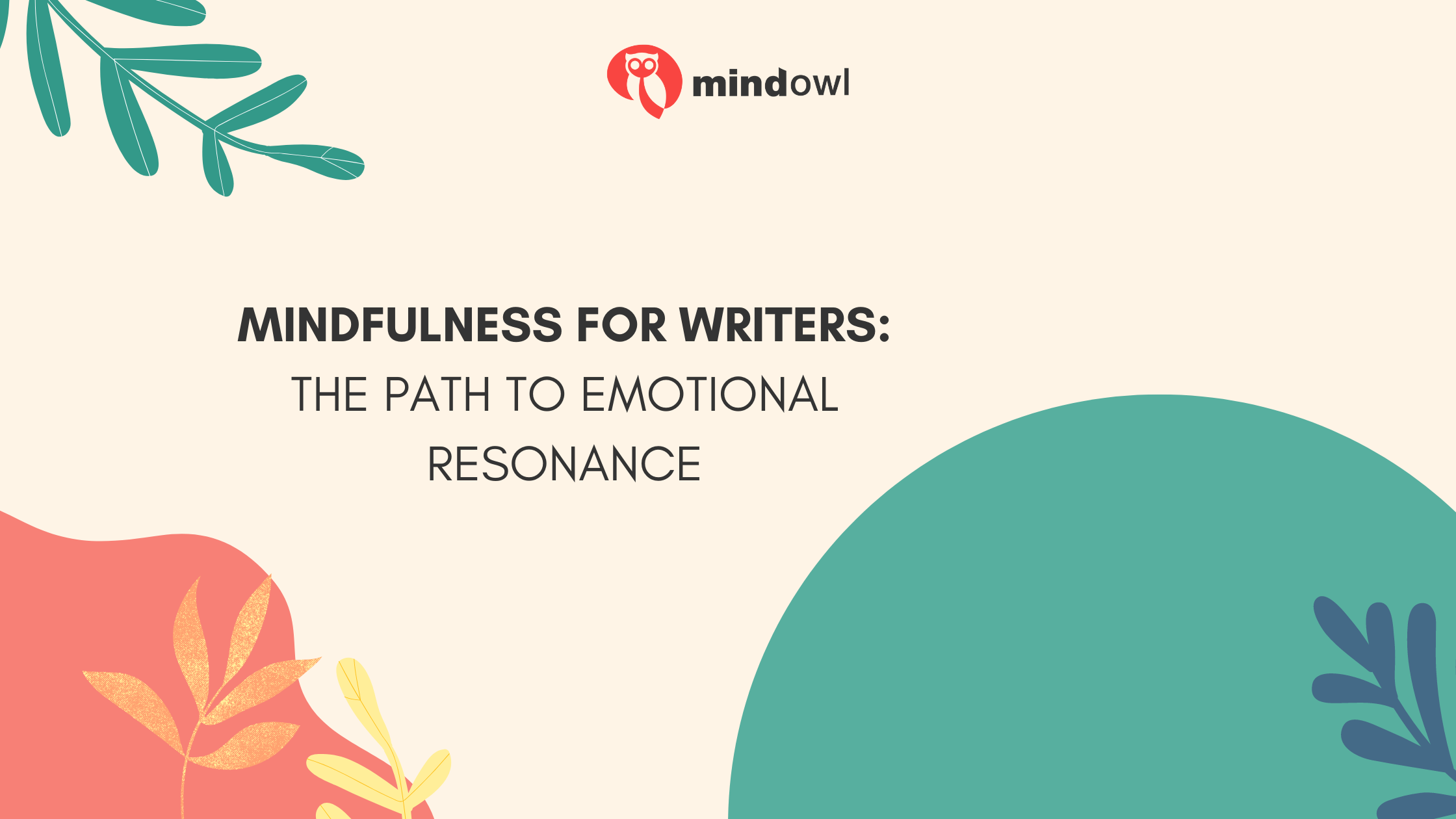Struggling to make your writing touch the hearts of readers? Emotional resonance is key. It’s all about creating feelings that stick with people long after they’ve finished reading.
This article will guide you through blending mindfulness and storytelling techniques to pack a hefty emotional punch into your work. Ready to connect deeper?
Key Takeaways
- Emotional resonance helps readers connect deeply with stories by evoking strong feelings.
- Mindfulness enhances writing by improving self-awareness and focus.
- Using sensory details brings stories to life, allowing readers to experience what characters do — smelling, hearing, seeing — which strengthens emotional connections.
- To convey genuine emotion in writing, authors should draw from personal experiences, describe physical sensations linked to feelings, and develop relatable characters.

Understanding Emotional Resonance in Writing
Understanding Emotional Resonance in Writing is crucial for captivating readers. It involves evoking feelings and creating a deep connection with the audience. This can be achieved by incorporating relatable characters, using sensory details, and showing emotions rather than telling.
The ability to evoke emotions and create a connection with readers
Writers must tap into their feelings to reach the hearts of their readers. Using sensory details, they make scenes come alive. This helps people see, smell, taste, hear, and touch through words.
Characters need clear desires and motivations for readers to care about them. When characters laugh or cry, readers do too.
“Emotions are what makes a story stick in your mind long after you’ve turned the last page.”
Mindfulness plays a big part here. It sharpens writers’ awareness of their inner world and that of their characters. With this skill, writers can show rather than tell emotions. This builds a strong emotional connection between the reader and the story. For those struggling with this aspect, consulting a ghostwriter could provide valuable guidance.
Importance of emotional resonance in writing
Emotional resonance makes stories stick in our hearts. This power ties readers to characters, making them feel real emotions. Think of it like magic in Harry Potter books—it pulls you into the world of Hogwarts and makes you care about Harry’s journey.
Achieving this connection means tapping into shared feelings and experiences that most people understand. Whether it’s joy, sorrow, or anger, details that trigger these emotions make your writing come alive.
To get emotional resonance right, writers often need to face uncomfortable feelings themselves. This bravery allows them to describe emotions with depth and authenticity. Practices like meditation can help here by improving self-awareness and empathy towards others’ experiences.
Cultivating Emotional Resonance in Your Writing
Getting in touch with your own emotions
Understanding your own feelings is key to making readers feel something too. Think about times when you felt sad, joyful, or scared. What made you feel that way?
Writing with true feelings requires being honest about your emotions. Pay attention to the world around you and how it makes you feel. Meditation can be a great tool here. It helps you see your thoughts and emotions clearly.
Creating relatable and dynamic characters
Writers must dig deep into their own experiences to craft characters that readers feel for. They pull from joy, sadness, and everything in between to make each character’s journey something real.
This method makes stories stick with us long after we’ve turned the last page. It’s about blending emotional depth with growth, aiming for a blend that feels just right.
“A character’s first job is to make the reader care.”
– Author Unknown
Using emotional triggers and showing instead of telling
Emotional triggers pull readers into the story. They make characters and situations feel real. Here are ways to use these triggers effectively, showing rather than just telling:
- Choose details that spark emotions. Describe a character’s trembling hands or a tear sliding down their cheek instead of just saying they’re scared or sad. This helps readers feel the emotion themselves.
- Use powerful dialogue. Let characters express their feelings through what they say. A character whispering “I wish I could stay” is more moving than simply writing that they don’t want to leave.
- Create intense scenes with sensory descriptions. Describe how the air smells like rain before a storm or how a room sounds when it’s too quiet after an argument. Sensory details can evoke strong emotions.
- Lean on personal experiences for authenticity. Think of your own feelings in similar situations and describe those. If you’ve felt loss, recall that pain to portray a character’s grief authentically.
- Show the physical impact of emotions on characters. Maybe someone’s heart races with excitement, or their stomach churns with anxiety. Physical reactions help readers connect with what the character is going through.
- Reveal emotions through actions, not just thoughts or words. A character slamming a door shows anger better than saying they’re mad.
- Avoid clichés in emotional scenes. Find unique ways to express feelings instead of relying on phrases we’ve all heard before.
- Build empathy by presenting relatable struggles and flaws in your characters so readers can see parts of themselves in your story.
Each point focuses on immersing readers deeply into the narrative by evoking genuine emotional reactions, making the experience vivid and impactful without directly stating what those emotions are supposed to be.
The Role of Mindfulness in Writing
Being present and aware while writing
Focus on the now while writing. This means you catch every detail and emotion as they flow through your mind. Mindfulness lets you feel each word, making your work rich and alive. It’s like holding a bright light over your thoughts, seeing clearly what works and what doesn’t.
Meditation sharpens this focus, helping you dive deep into your feelings and those of your characters.
Being aware helps you avoid distractions that can dull your creativity. You’ll notice when anger or joy bubbles up inside, giving life to dynamic characters readers will relate to. Use these moments to create stories that stick with people long after they’ve finished reading.
Honing your craft and improving your writing through mindfulness
Being present and paying attention while you write helps you understand your feelings better. When you know how they feel, it’s easier to put them into words that touch people’s hearts.
Think of mindfulness as a tool, like a brush for an artist, helping you paint clearer pictures with your words.
Using mindfulness also means noticing the world around you more clearly. You might see things others miss. These details can make your stories richer and more believable.
Your readers will feel the sadness themselves without being told to feel it directly—showing rather than telling makes stories come alive. But if you ever face difficulties with mindfulness practices, seeking out reputable ghostwriting agencies could offer a fresh perspective and personalized coaching
Conclusion
Creating emotional resonance in writing is about evoking feelings and connecting with readers. To achieve this, writers must explore their own emotions and create relatable characters with clear motivations.
Mindfulness is crucial for writers to connect with their emotions and convey them effectively in their writing. By staying present whilst crafting stories, writers can immerse themselves in the emotions they wish to convey, leading to compelling narratives that resonate deeply with audiences.
FAQs
1. What is mindfulness for writers?
Mindfulness for writers is all about being present and fully engaged with your writing process, tapping into a state of consciousness that helps you connect deeply with your emotions — and through them, to your readers.
2. How can mindfulness improve my writing?
By practising mindfulness, you learn to observe your thoughts without judgement, leading to richer character development and plots that resonate emotionally.
3. Can mindfulness help me deal with writer’s block?
Absolutely! Mindfulness encourages curiosity and openness, helping you explore new ideas or perspectives when feeling stuck.
4. Does practising mindfulness require special tools or subscriptions?
Mindfulness simply requires a bit of quiet time and perhaps some guidance from experts at first.
5. Will I see immediate results if I start practising mindfulness for my writing?
While you may not get instant results, incorporating mindfulness into your routine can gradually transform your writing by deepening the emotional resonance between you and your audience.
6. How do I begin incorporating mindfulness into my daily writing practice?
Start small; dedicate a few minutes before each writing session to sit quietly, breathe deeply, and clear your mind of distractions.
MindOwl Founder – My own struggles in life have led me to this path of understanding the human condition. I graduated with a bachelor’s degree in philosophy before completing a master’s degree in psychology at Regent’s University London. I then completed a postgraduate diploma in philosophical counselling before being trained in ACT (Acceptance and commitment therapy).
I’ve spent the last eight years studying the encounter of meditative practices with modern psychology.


